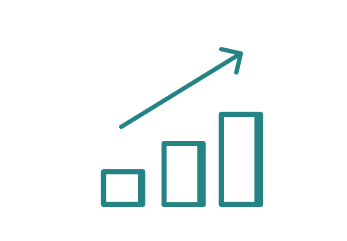With competition becoming more globalized, it can be difficult to find innovative ways to increase profits and stay competitive in the market. Automation can help, but it can be expensive to implement. However, there are many other ways your company can increase profits.
First, take a step back and look at its product lines and clients from a macro perspective. By identifying which products and services are the most and least profitable through a profitability analysis, it can help leaders make important decisions that will impact your company’s total economic value.
What is a profitability analysis?
Profitability analysis looks at a company’s costs and allocates these costs to different areas or segments—such as specific types of customers, age groups, geographic regions or product types—to evaluate profit within those segments. This enables a company to make better decisions about what types of customers or regions of the country to focus on. It can also help make choices about which products should be more widely marketed or cut completely, depending on the profit those segments are generating.
Many leaders think they know what their most profitable products/services are, but they are often surprised at the real answer. Because we work in a dynamic market with ever changing tastes, the most profitable products will change over time. Thus, it’s important to perform an ongoing profitability analysis to capture new opportunities and maximize returns.
How do I figure out what my most profitable products/services are?
Gather information from various departments
When trying to figure out product profitability, make sure you consult someone from every major department. This includes sales, marketing, operations and finance. For smaller companies, these functions are typically performed by only a few people which handle multiple roles, which makes the analysis much easier. Ask questions such as:
- Which products are sold together and why?
- What marketing channels are used
- What products are being sold through those channels?
- How are products delivered to the end customer?
- How are costs allocated to each product from shared services?
Identifying true product profitability is an investigation into the way costs are generated and assigned. Getting input from all key teams will allow you to develop a diverse perspective and lead to new insights.
Combine your products into segments
What is a segment?
Once the interviews are complete, separate the products into different segments. A segment is a group of products that are similar, sold to the same type of customers or are otherwise defined within a company. For example, at a company like Capital One may have a business banking segment, personal banking segment, credit card segment and wealth management segment, among others.
Measure profitability by segment
Understanding how your business is structured and the underlying costs associated with each area will help give a macro viewpoint that should be easier to understand and analyze. Go through each segment and measure its overall profitability. If you have access to a finance professional, it is best to solicit their help with this. There are many ways to assign costs within an organization, and a finance professional will be able to provide the right approach.
What key products are driving profitability?
Once the analysis is complete, you will have a better understanding of how well each product segment is doing. Now, take it one step deeper and ask:
- What key products are driving this segment’s profitability? This can shed light on certain products that may have unordinary high and low profit margins.
- Are these products typically bundled with others?
- Are there opportunities to lower prices of key high-profile products, or run sales campaigns around those products while simultaneously increasing prices on other products that are bought with it to increase overall profitability? Performing a price-volume-mix analysis is a great way to help identify these opportunities.
Look for risks and opportunities
By scrutinizing each segment, you will have a deeper understanding of potential risks or opportunities to adjust for.
Look for risks such as shifts in demand for the product due to increasing competition or the introduction of alternatives, or even potential policy interference from the government. Opportunities may include product spinoffs to create a new product line, temporary price adjustments to take market share from lagging competition, or growth opportunities in products that were not getting much attention by the company.
For example, a marketing agency that focuses on the hotel industry may find that franchise hotels and senior living facilities provide the highest profit margins, but apartment buildings do not. These risks and opportunities can be missed if company leaders never look at their product segments.
Analyze the data, don’t just report it
External factors can play a huge part in product profitability, but internal factors such as distribution costs and other efficiencies are equally as important. It’s critical to keep an open line of communication to allow for a stream of information between teams and departments.
For example, the sales team may have noticed that the sales of their top product is declining, but why? Is it price? Value? Competition? It could be a shift in the customer preference. Is the sales team effectively relaying this information to the marketing team? If not caught in time, competition could swoop in and grab a larger chunk of the market.
By continuously analyzing segment and product profitability, you are more likely to catch these changes and make adjustments before it’s too late.
Find profit through efficiencies
Understanding product profitability is not just about what internal and external factors are playing a role in your company’s profitability. You must also determine what your company can do to create efficiencies. Six-sigma or MVT (multivariable testing)—techniques intended to improve business processes by greatly reducing the probability that an error or defect will occur—can help companies identify inefficiencies in their customer service or product production techniques. These methodologies have many benefits and can help a company reduce cycle times, improve service and enhance strategic planning.
Take Walmart as an example. Early in its growth cycle, it sought to penetrate new markets by being the cheapest alternative. It adopted an efficiency-first strategy when it focused on rural markets, away from high-density suburban retail centers its competitors chose. Obviously, that strategy played out well.
By focusing on internal efficiencies and cost reduction techniques, a company can improve internal processes and remove redundant steps when making the product or delivering its service. This can lead to better understanding of the overall product production process, which will be essential when analyzing the product and company’s overall profitability.
What you need to unlock your company’s profit potential
By focusing on product profitability and making it an integral part of the strategic planning process, company leaders can have the greatest impact in driving change, enhancing the customer experience and improving overall company performance.
So, what resources do you need to accomplish this meaty task? You need:
- Good analytical skills to break apart all the different areas where costs may be in your company
- Communication skills to effectively interview key stakeholders
- A willingness to learn and change, as not everything that you believed to be true will necessarily be accurate
Companies often feel they don’t have the time or resources to undertake such a large project. The good news is that today, many small and mid-sized companies can easily outsource these types of projects to a part-time financial analyst. The cost of the profitability analysis will be paid for many times over in the resulting cost savings and profit increases from executing the recommendations.
At Paro, we leverage our proprietary AI technology to build flexible, focused teams of remote experts that help companies solve problems and drive growth. Our laser focus on finance allows us to quickly identify experts across the U.S. with the right mix of skills, credentials, and experience to achieve each company’s specific goals. Complete our form to request a consultation and get one step closer to gaining the profitability analysis your business needs.








